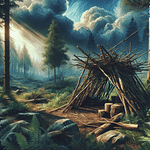How An Igloo Keeps You Warm
For thousands of years, humans, and plantsand animals long before that, have been usingfrozen “sky water” to keep warm. Which sort of doesn’t make sense. Because snow is cool. You might even say it’s… ice cold. YEEAAHHHHH!No one knows for sure who built the firstigloo, but with the right fit and the rightphysics, snow can actually warm you betterthan the inside of a tauntaun. “You’ll be ok, Luke!”So, how can something cold keep you cozy? The vast, frozen Arctic is one of the mostforbidding environments on our planet, yet,the Inuit have managed to live there for about5,000 years. Out on the pack ice, winter temperatures reach50 degrees below zero , and when it’s thatcold, surviving means finding shelter. It’s not an area known for its forests,so nomadic hunters learned to build with theonly thing available: snow. Eskimo languages really do have dozens anddozens of different words for snow, becausethere are a lot of different types, and thetype of snow you choose can dictate whetheryour igloo keeps you warm, or turns you intoa Homo sapiensicle. To understand this, we need to know a littlesomething about being cold. When your body temperature starts to plummet– you’re feeling heat leave you. Cold can’t move into your body – in fact,there is no such thing as cold. Where have I heard that before?Oh, right!Think of heat as an actual quantity of stuff:. The more you give away, the colder you feel. This trading of heat can happen three differentways: by convection, conduction, and radiation. All three are at play in an igloo. A person inside will radiate body heat, whichmoves around the igloo by convection, andis lost through the walls by conduction. This is exactly what happens in your house. Living insulation does the same thing. Fatty tissues like blubber help stop heattransfer in whales and seals, but for animalswho don’t have as much junk in the trunk,they cover themselves in air. Sea otter fur, for example, is about a thousandtimes denser than human hair. It’s snuggly stuff“This is the softest thing I’ve ever feltin my life. You are adorable!”…but the secret to its insulation poweris in its texture. Otter fur is spiky, so it traps insulatingair molecules. And that is exactly what snowflakes do. Powdery, fresh snow can be up to 95% trappedair. This makes it an excellent insulator, butthe same way you have to pack it in your handsto make a snowball, it isn’t dense enoughto build with. Solid ice, on the other hand, makes a goodwindbreaker, but it’s too heavy to lift. Inuit hunters took the Goldilocks approach:the secret to good igloo snow is somewherein the middle. Traditional igloo blocks aren’t molded,they’re cut out of the ground. That tightly-packed ground snow is dense enoughto hold up, but because it still has far moreair pockets than a block of ice, it’s light,and still a pretty good insulator. As usual, animals figured this one out longbefore humans. Polar bears, groundhogs, even birds like grouseall make snow burrows to stay warm. And even before that, plants were tuckinginto snow to avoid death by freezing. During the warm months, heat energy from thesun builds up in soil, and just like the theroof above your head, a deep covering of snowprevents that heat from escaping onward andupward. This snowy blanket above stops ice crystalsfrom forming inside plant roots, and shoots,and seeds. Not freezing to death is a pretty good motivatorfor any animal to get crafty, but our bigprimate brains took it one step further withigloos. Their engineering maximizes warmth and stability. Cartoon igloos look like flat-bottomed half-spheres,but in reality, they’re neither of thosethings!If you were to slice a real igloo in half,you’d see a shape called a catenary. This gradually sloping shape is the same onethat would form if you held a chain from bothends and let it droop. A catenary arch distributes weight more evenlythan a half circle, without bulging or buckling. In fact it’s one of the most stable archesin nature, so sound that we still use it today. Inside, snow houses are carved in differentlevels. The hot air rises, and the cold air sinksdown into the lower part, and away from whereyou would eat, sleep, and chill. To boot, body heat melts the innermost layerof the walls, strengthening the barrier betweenyou, your airy snow-block insulation, andthe frigid great beyond. When you live in an igloo, you act as a livingfurnace. Over time, the temperature in your icy abodecan hover some 40-60 degrees above the surroundingair, but bring a friend to your igloo party,and you’ll get warmer, faster. Stay cozy, and stay curious!”Hey, you remember that thing I said abouteskimos having all those different words forsnow?Well our friends from Idea Channel made avideo about that. Here’s an idea, you should go check it out. It’s pretty cool. “



